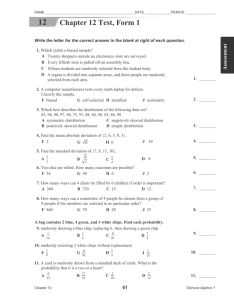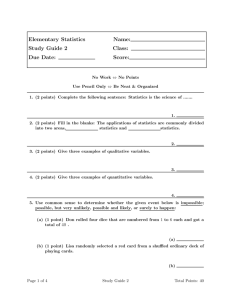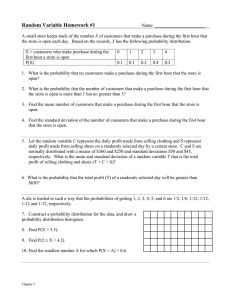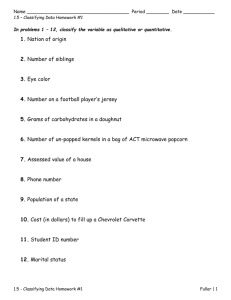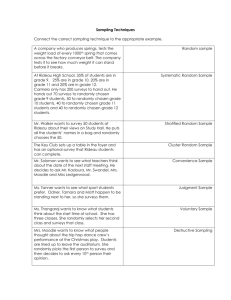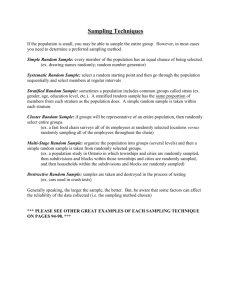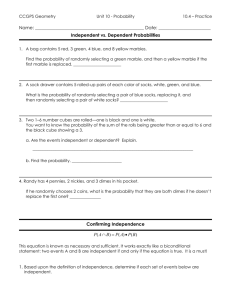Independent and Dependent Events Now
advertisement
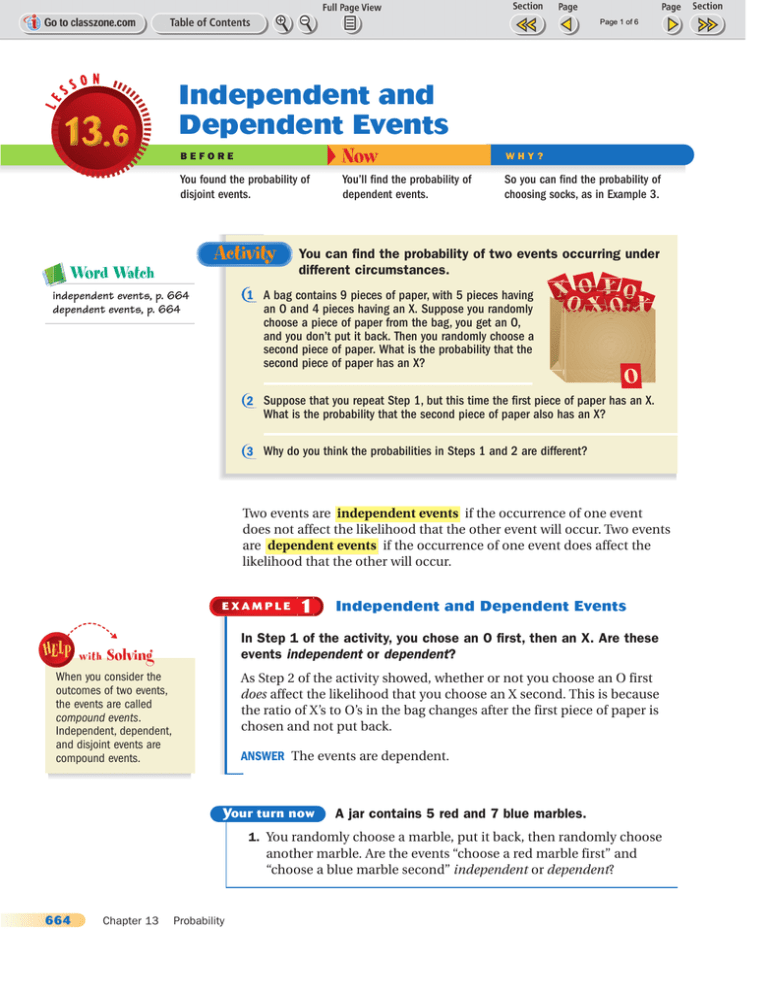
Page 1 of 6 Independent and Dependent Events BEFORE Now WHY? You found the probability of disjoint events. You’ll find the probability of dependent events. So you can find the probability of choosing socks, as in Example 3. You can find the probability of two events occurring under different circumstances. Word Watch 1 A bag contains 9 pieces of paper, with 5 pieces having an O and 4 pieces having an X. Suppose you randomly choose a piece of paper from the bag, you get an O, and you don’t put it back. Then you randomly choose a second piece of paper. What is the probability that the second piece of paper has an X? independent events, p. 664 dependent events, p. 664 2 Suppose that you repeat Step 1, but this time the first piece of paper has an X. What is the probability that the second piece of paper also has an X? 3 Why do you think the probabilities in Steps 1 and 2 are different? Two events are independent events if the occurrence of one event does not affect the likelihood that the other event will occur. Two events are dependent events if the occurrence of one event does affect the likelihood that the other will occur. EXAMPLE with 1 Independent and Dependent Events In Step 1 of the activity, you chose an O first, then an X. Are these events independent or dependent? Solving When you consider the outcomes of two events, the events are called compound events. Independent, dependent, and disjoint events are compound events. As Step 2 of the activity showed, whether or not you choose an O first does affect the likelihood that you choose an X second. This is because the ratio of X’s to O’s in the bag changes after the first piece of paper is chosen and not put back. ANSWER The events are dependent. Your turn now A jar contains 5 red and 7 blue marbles. 1. You randomly choose a marble, put it back, then randomly choose another marble. Are the events “choose a red marble first” and “choose a blue marble second” independent or dependent? 664 Chapter 13 Probability Page 2 of 6 In common usage, being independent means being free from the control of others. This may help you remember the meaning of independent events. 1p3 2p6 P(H and odd) 1 3 p 2 6 P(H) p P(odd) T 1 H, 1 T, 1 2 H, 2 T, 2 3 H, 3 T, 3 4 H, 4 T, 4 5 H, 5 T, 5 6 H, 6 T, 6 This result suggests the following rule. Probability of Independent Events Words For two independent events, the probability that both events occur is the product of the probabilities of the events. Algebra If A and B are independent events, then P(A and B) P(A) p P(B). EXAMPLE 2 Probability of Independent Events BAN KRU PT 1 Find the probability of each event. 2 8 P($200) 0.25 $ $ 3 2 0 0 0 0 $ 1 0 0 Game Show As a contestant on a game show, you need to spin the money wheel at the right, which is divided into equal sections. Find the probability that you get $200 on your first spin and go bankrupt on your second spin. $ 1 0 0 Vocabulary H LOS E TU RN $ $ 3 2 0 0 0 0 with Independent Events A coin is flipped and a number cube is rolled. The table of outcomes helps you see the relationship between the probability of two events together and the probabilities of the individual events. “$200” appears 2 times. 1 8 P(bankrupt) 0.125 “Bankrupt” appears once. 2 Because the events are independent, multiply the probabilities. P($200 and bankrupt) P($200) P(bankrupt) 0.25 0.125 0.03125 ANSWER The probability that you get $200 on your first spin and go bankrupt on your second spin is 0.03125, or about 3%. Lesson 13.6 Independent and Dependent Events 665 Page 3 of 6 Dependent Events If A and B are dependent events, the probability that B occurs given A is not the same as the probability of B. So, you should use P(B given A) instead of P(B) to represent the probability that B will occur given that A has occurred. Probability of Dependent Events Words For two dependent events, the probability that both events occur is the product of the probability of the first event and the probability of the second event given the first. Algebra If A and B are dependent events, then P(A and B) P(A) p P(B given A). EXAMPLE 3 Probability of Dependent Events Socks A drawer has 12 white, 7 black, and 6 striped socks. You randomly choose 1 sock from the drawer, then randomly choose another sock without replacing the first. Find the probability that both are white. Solution Find the probability of the first event and the probability of the second event given the first. Then multiply the probabilities. 12 25 1 P(white) Of the 25 socks, 12 are white. 11 Of the remaining 24 socks, 11 are white. 2 P(white given white) 24 12 11 3 P(white and white) 25 24 Multiply probabilities. 1 12 11 25 24 Divide out common factor. 11 50 Multiply. 2 11 50 ANSWER The probability that both socks are white is , or 22%. Your turn now Refer to Example 3. 2. Find the probability that both socks are black when the first sock chosen is not replaced. 666 Chapter 13 Probability Page 4 of 6 INTERNET Exercises eWorkbook Plus CLASSZONE.COM More Practice, p. 717 Getting Ready to Practice 1. Vocabulary Explain the difference between independent and dependent events. Events A and B are independent events. Find P(A and B). 2. P(A) 0.3 P(B) 0.7 3. P(A) 0.5 4. P(A) 0.8 P(B) 0.5 P(B) 0.2 Events A and B are dependent events. Find P(A and B). 5. P(A) 0.9 P(B given A) 0.8 6. P(A) 0.6 7. P(A) 0.25 P(B given A) 0.25 P(B given A) 0.2 8. Baseball You are watching a baseball game. Tell whether the events are independent or dependent. Event A: The third batter in the lineup hits a home run. Event B: The fourth batter in the lineup hits a home run. Practice and Problem Solving with Example 1 2 3 Homework Exercises 9–10 11–13, 18–20 14–16, 21–22 Online Resources Tell whether the events are independent or dependent. 9. You roll a number cube and get a 5, and you flip a coin and get tails. 10. Your CD player has a random play button that chooses songs at random and plays each song exactly once before repeating. While listening to a CD in random play, you hear track 3 first and track 1 second. CLASSZONE.COM • More Examples • eTutorial Plus Events A and B are independent events. Find the unknown probability. 11. P(A) 0.6 P(B) 0.3 P(A and B) _?_ 12. P(A) 0.2 P(B) _?_ P(A and B) 0.08 13. P(A) _?_ P(B) 0.5 P(A and B) 0.35 Events A and B are dependent events. Find the unknown probability. 14. P(A) 0.25 P(B given A) 0.5 P(A and B) _?_ 15. P(A) 0.4 P(B given A) _?_ P(A and B) 0.36 16. P(A) _?_ P(B given A) 0.3 P(A and B) 0.09 17. Writing Describe a way to randomly choose one of the 6 lettered tiles, then another, so that the events are independent. Lesson 13.6 Independent and Dependent Events 667 Page 5 of 6 Shoes The tables give data about the shoes manufactured at a factory during a day. Assuming that the events are independent, find the probability that a randomly chosen pair of shoes has the given description. 18. Men’s athletic shoes 19. Women’s casual shoes 20. Men’s casual shoes Gender Men’s Women’s Percent 46% 54% Shoe Style Athletic Casual Dress Percent 22% 61% 17% Each whole number from 1 through 10 is written on a separate piece of paper. You randomly choose numbers one at a time, but you do not replace them. Find the probability that both events A and B will occur. 21. Event A: The first number you choose is an odd number. Event B: The second number you choose is an odd number. 22. Event A: The first number you choose is a 2. Event B: The second number you choose is an even number. In Exercises 23 and 24, tell whether the situation describes independent events or dependent events. Then answer the question. Art 23. Gumballs A bag contains 24 blue, 20 green, and 16 yellow gumballs. You randomly choose a gumball from the bag, and you do not replace it. Then you randomly choose another gumball. What is the probability that both gumballs are green? 24. Shopping The table shows the T-shirts on a ■ clearance rack at a clothing store. Suppose that you randomly choose one T-shirt and put it back. Then you randomly choose a second T-shirt. What is the probability that the first T-shirt is a small and the second T-shirt is a large? Gumballs The elephant shown above is part of a gumball mural by Franz Spohn. He used 14,300 gumballs to create the rectangular mural, which is 8 feet long and 6 feet wide. How many gumballs are in 1 square foot of the mural? Round your answer to the nearest whole number. 668 Chapter 13 Probability Size Number Small 12 Medium 24 Large 14 25. Perform an Experiment First, roll 2 number cubes 25 times. For each roll, record whether you get 2 of a kind. What is the experimental probability of getting 2 of a kind? Now, suppose you roll the 2 number cubes 2 more times. Use your experimental probability from the first 25 rolls to find the probability of getting 2 of a kind for both of the rolls. 26. Challenge The table shows the size and color of paper clips in a box. You randomly choose paper clips one at a time from the box, but you do not replace them. What is the probability that the first three paper clips that you choose are small and yellow? Small Large Red 10 10 Blue 10 10 Yellow 15 15 Page 6 of 6 Mixed Review Write the decimal as a percent. (Lesson 9.3) 27. 0.364 28. 0.0048 29. 2.35 In Exercises 31 and 32, use the table at the right, which shows the results of a survey that asked students their favorite type of pet. (Lesson 13.5) 31. What is the probability that a randomly selected student voted for a cat or a bird? 32. What is the probability that a randomly selected 30. 0.10006 Pet Percent Dog 36% Cat 31% Bird 12% Other 21% student voted for a dog or a cat? Basic Skills Find the product. 33. 5 1.7 34. 6.8 4.1 35. 8.44 2.5 36. 9.9 3.33 Test-Taking Practice 37. Extended Response Each of the letters in the word PROBABILITY INTERNET State Test Practice CLASSZONE.COM is written on a separate piece of paper and put in a bag. Which of the methods of selecting two letters will have a greater probability of getting two B’s? Explain your reasoning. Method 1: You randomly choose a letter from the bag, but you don’t replace it. Then you randomly choose another letter. Method 2: You randomly choose a letter from the bag and replace it. Then you randomly choose another letter. What’s in the bag? A bag contains blue, red, orange, and green cubes, and there are 50 cubes in the bag. The probability of randomly choosing each cube is listed below. How many cubes of each color are in the bag? 14% 42% 26% 18% Lesson 13.6 Independent and Dependent Events 669
